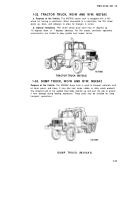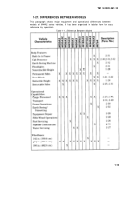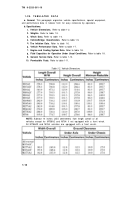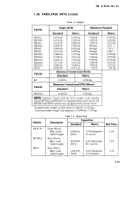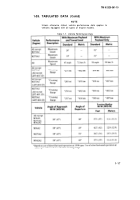TM-9-2320-361-10 - Page 46 of 392
TM9-2320-361-10
1-28. TABULATED DATA (Contd)
Table 1-11. Permissible Fuels (Contd)
Fuel
Temperature limits
Commercial aviation turbine fuel
Do not use below -52°F (-47°C)
(ASTM D1655), jet A-1
Any mixture of primary and/or
*
alternate I fuels listed above
WARNING
Never mix gasoline or JP-4 turbine fuel with other fuels outside
vehicle fuel tank. Any mixing should be done by adding fuels to fuel
tank. Gasoline and JP-4 turbine fuel are highly combustible and may
explode, resulting in injury or death to personnel.
CAUTION
If engine runs rough when using any alternate II fuel, add 10% to
30%, diesel fuel to smooth engine performance. Failure to add diesel
fuel may result in damage to pistons.
Alternate II Fuels
Turbine fuel, MIL-T-5624, grade JP-4
Do not use below -72°F (-58°C)
(NATO code no. F-40)
Turbine fuel, aviation, naphtha-type
Do not use below -58°F (-50°C)
(ASTM D1655), jet B
Gasoline, unleaded/low-leaded,
*
VV-G-001690, special grade (91/82)
Combat gasoline, MIL-G-3056, MOGAS
Do not use below 0°F (-18°C)
(NATO code no, F-46)
Gasoline, automotive
*
(NATO code no. F-50)
Gasoline, W-G-76, regular and premium
*
grades
Gasoline, unleaded/low-leaded,
*
W-G-001690, regular and premium grades
Aviation gasoline, MIL-G-5572,
Do not use below -75°F ( -59°C)
AVGAS 100/300 (NATO code no. F-18)
Commercial aviation gasoline
Do not use below -72°F (-58°C)
(ASTM D910), grade 100/130
Commercial gasoline (ASTM D439), leaded,
*
low-lead, or unleaded, where research octane
number is above 90, or octane number displayed
on retail gasoline pumps in CONUS is above 86
Any mixture of alternate II with primary,
*
alternate I, and/or alternate II fuels listed above
* Any temperature at which fuel will flow.
1-21
Back to Top

